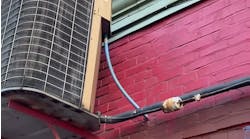Chapter 6 of the NEC, which covers “Non-Typical or Specialized Areas of Work,” is impacted or heavily influenced by changes in technology and legal legislation. Article 625 covers the installation of equipment and devices related to electric vehicle charging for on-road use, such as passenger automobiles, buses, trucks, vans, neighborhood electric vehicles, electric motorcycles, primarily powered by an electric motor that draws current from a rechargeable storage battery, fuel cell, photovoltaic array, or other source of electric current with nominal AC system voltages of 120, 120/240, 208Y/120, 240, 480Y/277, 480, 600Y/347, 600, and 1000 and DC system voltages of up to 1,000. It also covers electrical conductors and equipment external to an electric vehicle that connect an electric vehicle to a supply of electricity by: inductive means, conductive means, and wireless power transfer (contactless inductive charging) in the following configurations:
- Level 1 Charger: 120VAC 15A
- Level 2 Charger: 120-240VAC 60A
- Level 3 Charger: 480 VAC 125A or 600 VDC 550A
- Level 4 Charger: DC ultra-fast chargers
Important terms to know
The definitions in Sec. 625.2 (2017 edition of the NEC) has several essential terms you should familiarize yourself with as you begin to perform installations in this fledging section of the electrical industry; you should also understand brand/model-specific installation requirements and best practices. Always read the installer’s guide provided by the equipment manufacturer; the NEC is a supplement to the installer's guide provided with the charging equipment. It's vital that you learn how to identify each part of an EV charging system. Show the boss and your peers that you invested time and resources to understand these definitions and installation requirements.
Invest in yourself
If you can get "certified" as an installer, do it! Most Level 1 and Level 2 EV charging manufacturers offer free training courses on their websites. Most of these courses are virtual, and you can take them from the comfort of your home. In some cases, to be certified as a Level 3 and Level 4 installer, you might be required to complete 20 hours of training and pass an exam to obtain certification — the requirements vary based on the manufacturer or organization hosting the program. Some of these higher-level courses might require you to be licensed as an electrical contractor or a certified electrician; they may require documentation of a minimum of 8,000 hours of hands-on electrical construction experience. Please do your research; it'll pay off for decades.
Don’t get creative!
Per Sec. 625.15 (Markings (A) General), all equipment shall be marked by the manufacturer as follows:
FOR USE WITH ELECTRIC VEHICLES
Only use equipment and devices that are specifically designed for electric vehicles. Use equipment that is listed and labeled for such use. 625.16 (Means of Coupling) Attachment plugs, electric vehicle connectors, and electric vehicle inlets shall be listed or labeled for the purpose.
The means of coupling to the electric vehicle shall be conductive, inductive, or wireless power transfer. All these requirements affect the Automobile manufacturer's:
- Vehicle charging times
- Information exchange to vehicle
- Amount of power transfer to vehicle
- Vehicle charging performance integrity specifications
Cord and cables feeding EVs
Per Sec. 625.17 (A), power supply cord and portable power cable for connected equipment shall be listed for exposure to oil, damp, and wet locations (where required) shall be hard service cord or junior hard service cord. As noted in Sec. 625.17 (B), the output cable to the electric vehicle shall be Type EV, EVJ, EVE, EVJE, EVT, or EVJT flexible cable. The overall usable length shall not exceed 25 ft unless equipped with a cable management system that is part of the listed electric vehicle supply equipment in Sec. 625.17 (C).
Fastened in place or not fastened in place
Where the electric vehicle supply equipment or charging system is not fastened in place, the cord-exposed usable length shall be measured from the face of the attachment plug to the face of the electric vehicle connector, as noted in Sec. 625.17 (C)(1). Where the electric vehicle supply equipment or charging system is fastened in place, the usable length of the output cable shall be measured from the cable exit of the electric vehicle supply equipment or charging system to the face of the electric vehicle connector per Sec. 625.17 (C)(2).
Electric vehicle branch circuit and overcurrent protection requirements
Each outlet installed for charging electric vehicles shall be supplied by an individual branch circuit; each circuit shall have no other outlets. Overcurrent protection for feeders and branch circuits supplying equipment shall be sized for continuous duty and shall have a rating of not less than “125% of the maximum load” where noncontinuous loads are supplied from the same overcurrent device shall have a rating of not less than the sum of the noncontinuous loads plus “125% of the continuous loads” as required in Part III Installation of Secs. 625.40 and 625.41.
EV charging equipment rating and disconnecting means
Electric vehicle charging loads shall be considered “continuous loads.” Equipment shall have a sufficient rating to supply the load served. Where an automatic load management system is used, the maximum equipment load on a service and feeder shall be the maximum load permitted by the automatic load management system. For equipment rated at more than 60A or more than 150V to ground, the disconnecting means shall be provided and installed in a “readily accessible” location (Secs. 625.42 and 625.43). This is a term found in Chapter One of the NEC [Article 100 Definition]: "Capable of being reached quickly for operation, renewal, or inspections without requiring those to whom ready access is requisite to take actions such as to use tools (other than keys), to climb over or under, to remove obstacles, or to resort to portable ladders, and so forth." The disconnecting means shall be lockable "open" (Sec. 110.25); it shall be capable of being locked in the open position. Locking provisions shall remain in place "with" or "without" the lock installed with one exception — locking provisions for a cord-and-plug connection "shall" not be required to remain in place without the lock installed.
Follow my column for more practical how-to articles and tips for applying electric basics concepts in the field. Past columns include Everyday Instructions for Electricians, The Apprentices Guide to Special Equipment, The Apprentice’s Intro Guide to Motors, The Apprentice’s Guide to Service Entrance Cable, The Apprentice’s Guide to NEC Art. 382, and The Apprentice’s Guide to NEC Art. 550. For more information on why a structured approach is so important to navigating the NEC and how to put its requirements into practice in real-world settings, read “The NEC for Newbies.”
Harold De Loach, a master electrician and electrical trainer/instructor, is the founder of The Academy of Industrial Arts (www.taia-school.com) in Philadelphia. With more than 30 years of experience in the field, he writes regular exclusive content for the E-Train and can be reached at [email protected].




